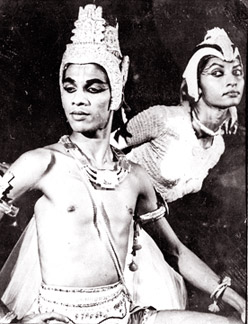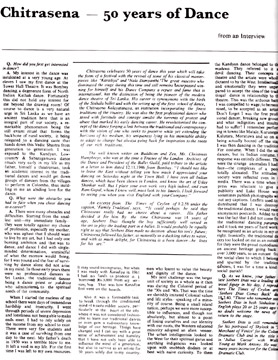Chitrasena reminisced
Part 1
Chitrasena celebrates 50 years of dance this year which will take the
form of a festival with the revival of some of his classical
masterpieces like ‘Karaliya’ and ‘Nala Damayanthi’.
| He would
have turned a nonagenarian had he been among us today. Born
Amaratunga Arachige Maurice Dias, Chitrasena is
internationally known for his work in establishing a modern
Sri Lankan tradition of dance and popularizing traditional
Sri Lankan dance forms worldwide. Daily News Artscope
reproduces the account of Chitrasena as laid down in Nrtya
Puja, which was published in 1986 to celebrate 50 years of
his contribution to the country’s art. |
The great maestro who dominated the stage during this time and still
remains unsurpassed winning for himself and his Dance Company a repute
and fame that is international, has the distinction of being the pioneer
of the modern dance theatre of Sri Lanka. His career is synonymous with
the birth of the Sinhala ballet and with the setting up of the first
school of dance, the Chitrasena Kalayatanaya, an institution
incorporating the finest traditions of the country.
He was also the first professional dancer who stood with fortitude
and courage amidst the torrents of protest and abuse that marked his
early dancing career. He revolutionalised the concept of the dance
forging a link between the traditional and contemporary with the vision
of one who seeks to preserve while yet extending the horizons of his
medium, his uniqueness lying in his inimitable ability to adopt to
change but always going back for inspiration to the roots of our rich
traditions.
The well known writer on Buddhism and Zen, Mr. Christmas Humphreys,
who was at the time a Trustee of the London Archives of the Dance and
President of the Ballet Guild, paid tribute to the artiste in a letter
to him dated 12.11.1946 from Bombay. “I should not like to leave the
East without telling you how much I appreciated your dancing on Saturday
night at the Town Hall. I have seen all Indian dances, which have been
shown in London, and know the art of Uday Shankar well.
But I place your own work very high indeed, and even Ram Gopal, whom
I know well, must look to his laurels. I look forward to seeing you when
you visit England with your Company.”
An excerpt from The Times of Ceylon of 1.2.58 under the caption,
‘Family Tradition’, says, “It could perhaps be said that Chitrasena
really had no choice about a career. His father decided it for him. By
the time Chitrasena was 14 years of age, Seebert Dias thought the boy
sufficiently well versed in the art to pay the leading part in a ballet.
It would probably be equally right to say that Seebert Dias made no
decision about his son’s future; Chitrasena followed his father, as
naturally as a ducking takes to water, and with as much delight for
Chitrasena is a born dancer - he lives for his art.”
Q: How did you first get interested in dance?
A: My interest in the dance was inculcated at a very young age. At
eleven I saw my first dance at the Tower Hall Theatre. It was Bombay
dancing, a degenerate form of North Indian Kathak dance.
 |
|
Chitrasena
in performance |
 |
|
Chitrasena |
Fortunately this did not hold any interest for me beyond the drawing
room! Of course to dance is a very natural urge in Sri Lanka as we have
an ancient tradition here that is an integral part of our society, a
remarkable phenomenon being the still extant ritual that forms the
backbone of rural society, it being relegated to a dancing caste that
hands down this Vedic Shastra from generation to generation.
Iw as exposed to the Kandyan, Low country and Sabaragmuwa dance
rituals very early in my life as my father, himself a theatre man, took
an academic interest in the traditional dances and would get down groups
of dancers from the villages to perform in Colombo, thus instilling in
me an abiding love for the dance.
Q: What were the obstacles you had to face when you chose dancing as
a career?
A: There were many obstacles and difficulties. Starting from the
smallest unit – my immediate family – they were totally against my
choice of profession, especially my mother, who was aghast that I should
want to live by my art, but I had only one burning ambition and that was
to dance, and dance I did with singleminded determination, unmindful of
what the morrow would bring, for I was young and the fear of surviving
by dance alone did not arise in my mind.
In those early years there were no professional dancers in Sri Lanka,
the traditional dancer being a dance priest or yakdessa who administered
to the spiritual needs of the community. When I started the nucleus of
my school there were days of tremendous hardship and insecurity.
I went through periods of severe depression and loneliness not being
able to make ends meet. I had to rely solely on the income from my
school to exist. There were very few students and it was a case of
surviving from one day to the next.
My father’s death in 1950 was a terrible blow to me. It left a void
in my life. For the first time I was left to my own resources.
It may sound incongruous, but when I was ready with Karadiya in 1961
I had no funds to produce it, I borrowed Rs 3,000 from my servant boy.
That was how Karadiya first went on the boards.
 Also it was a formidable task to break through the conditioned mind
of a caste-ridden society, particularly in the heart of the city where
it was not considered fashionable to learn our traditional dances or
even gain a rudimentary knowledge of our heritage. Also it was a formidable task to break through the conditioned mind
of a caste-ridden society, particularly in the heart of the city where
it was not considered fashionable to learn our traditional dances or
even gain a rudimentary knowledge of our heritage.
Things have changed and I can say with a great sense of achievement
and humility that I have not only been able to influence the mind of a
generation, but also to survive as an artiste for 50 years solely due to
my country men who learnt to value the beauty and dignity of the dance.
My next challenge was the larger unit of society as a whole as it then
was during the Colonial
period of the ‘30s and ‘40s. That was the time we slavishly imitated
Colonial values and lifestyles - speaking of a minority of course. Being
a small island nation, perhaps we were more susceptible to influences,
and though not absolutely, but almost to a point of losing ourselves and
our identity with our roots, the Western educated minority adopted an
alien veneer. The urban intelligentsia looked to the West for their
spiritual gurus and anything indigenous was looked upon with snobbish
disdain or at best with naive curiosity. To them the Kandyan dance
belonged to the maduwa.
They referred to it as devil dancing. Their concepts of theatre and
the artiste were wholly dictated to by the West. Intellectually and
emotionally they were unprepared to accept the idea of the traditional
dance in relationship to the theatre.
This was the arduous battle I was compelled to wage; to be
recognised, to be accepted as an artiste. Don’t forget I was the first
professional dancer, breaking new ground, and what indignities and
insults I had to suffer! I remember performing in towns like Matale,
Kurunegala, Kalutara, Moratuwa and so on and being actually hooted off
the stage.
I was then dancing in the traditional Ves costume. When I did the
same dances, but in Indian costume, the response was entirely different.
These were the strange anomalies I had to face - the complexes of a
people totally alienated.
The attitudes of society were reflected even in the media. There was
a time when the press was reluctant to give any publicity and Lake House
would sometimes publish photographs without any captions. Leaflets used
to be distributed that I was destroying the traditional dance.
I would receive anonymous postcards. Added to this was the fact that
I did not come from the traditional dancing parampara and it took me
years of hard work to be recognised as an artiste in my own right.
Ironically, the traditional dancers too looked on me as an outsider,
for they were the proud custodians of an ancient heritage going back to
over 3,000 years, so an outcast from the social class to which I
belonged and spurned by the traditional dancers, I was for a time a kind
of social pariah!
|



